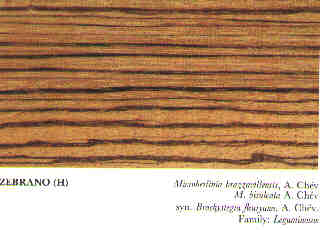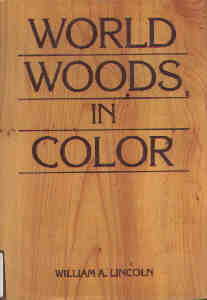 ZEBRANO
ZEBRANO
 ANNOTATION
ANNOTATIONWilliam Lincoln, a man to be admired, produced this book which required a tremendous amount of research. He obviously required even more patience to bring it to publication. For any serious marqueter this is an essential reference book.
When starting out to learn marquetry, veneers are usually selected for you as part of the kit. When you progresses to the stage of your own designs, veneers will be selected from a color chart provided by the supplier. But as you advance further you will find that you may want to look for a specific veneer, a close alternative or even a restoration piece. This is when a book like this will become indispensable.
I was impressed by the wealth of source reference material that Mr. Lincoln used from all the different countries of the world. I also liked his page on acknowledgments which read like the who’s who of the veneer and marquetry world. Our own (Canadian) John Sedgwick from Ontario is mentioned for his help in sending a range of Canadian hardwoods and softwoods.
WORLD WOODS IN COLOR contains information on over 275 commercial woods from world-wide sources.
The full-color illustrations show the timber's natural grain and features and each is fully annotated with relevant information including commercial and botanical names, distribution, general description, mechanical properties, seasoning, working properties, durability and a full range of uses for each wood. The woods are indexed for botanical, trade, commercial and local names, and family names, and there is a full bibliography of publications concerning timber study and identification.
This unique book will be a vital reference tool for all those concerned with timber studies and craftsmanship in wood as well as to the numerous trades and professions having to make decisions about which timber to use, its suitability for the job in hand, the alternatives and so on. Designers, architects, builders, woodworkers, restorers and antique dealers are among the many who will want to have their own copy near at hand.
Here is a publication sure to find an important place in reference libraries, schools and colleges, and the private libraries of all wood devotees.
EXTACTION
 ZEBRANO
ZEBRANO
(H) Microberlinia brazzavillensis, A. Chev
M. bisulcata A. Chev
syn. Brachystegia fleuryana, A. Chev
Family: Leguminosae
Commercial Names: zingana (France, Gabon); zebrawood (UK, USA); allene, ele, amouk
(Cameroon) .
Distribution: West Africa, chiefly Gabon and Cameroon Republic.
General Description: The heartwood is a light golden-yellow with narrow veining or streaks of dark brown to almost black, giving the quartered surfaces a zebra-stripe appearance. The grain is interlocked or wavy and produces alternating hard and soft grained material which makes the timber difficult to work. Zebrano has a coarse texture and a lustrous surface. Weight 74·0 kg/m3 (46 Ib/ft3); specific gravity .74.
Mechanical Properties: This hard, heavy, stable timber is mainly used for decorative purposes due to its nature, where strength and mechanical properties are unimportant.
Seasoning: The material is difficult to dry and requires care in order to avoid surface checking, splitting and distortion. There is small movement in service.
Working Properties: Although the wood works fairly readily with hand or machine tools, it is very difficult to get a good finish from machines due to the alternative nature of the grain. A belt sander will provide a smooth finish. Gluing is satisfactory with care, and it finishes well once filled.
Durability: Non-durable. Liable to attack by insects, and resistant to Preservative treatment. Uses: The main use for zebrano is as sliced decorative veneers for small cabinetwork, flush doors, cross bandings or inlay bandings, fancy goods, marquetry and panelling. Bundles of this veneer tend to buckle unless kept under weights. Also used by turners and carvers for decorative work.
 AUTHOR
AUTHOR
William Lincoln has for over thirty years been actively engaged in the veneer business. He has run his own plywood plant and his own veneer supply business from which he recently retired.
He is a professional member of the Timber Research and Development Association (TRADA), and a member of the International Wood Collectors Society.
He pioneered the revival of marquetry in Britain, is a former president of The Marquetry Society and their first life member. His tireless work for the furtherance of veneer crafts is well known, and his former company, The Art Veneers Co. Ltd., made available the widest possible selection of rare and exotic woods to craftsmen throughout the world.
He is the author of The Complete Manual of wood Veneering and The Art and Practice of Marquetry.